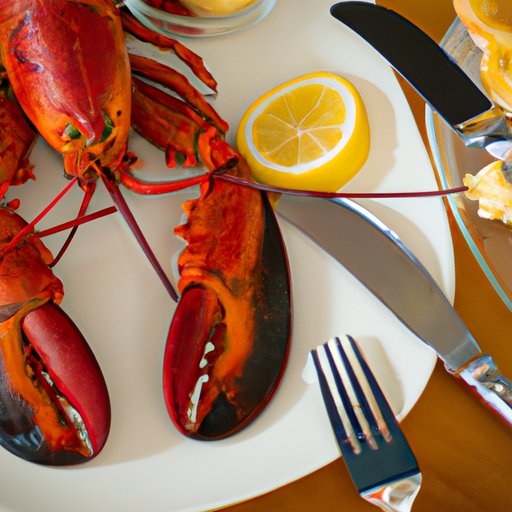Introduction
Lobster tails are a delicious seafood dish that can be cooked in a variety of ways. They are a great source of protein and essential vitamins and minerals. The key to enjoying lobster tails is to understand the basics of selecting, preparing, and cooking them. In this article, we’ll provide you with a step-by-step guide on how to eat lobster tails as well as discuss their nutritional benefits.
What is a Lobster Tail?
A lobster tail is the edible portion of the lobster located at the end of its body. It’s made up of the tail fan and the long, thick muscle that runs along the underside. Lobster tails vary in size depending on the species of lobster, but most are between 5-7 inches in length and 1-2 inches wide. Lobster tails can be found fresh, frozen, or pre-cooked.

Nutritional Value of Lobster Tails
Lobster tails are an excellent source of high-quality protein and essential vitamins and minerals. A single 3-ounce serving contains approximately 24 grams of protein and only 2 grams of fat. Additionally, lobster tails are rich in omega-3 fatty acids, vitamin B12, phosphorus, magnesium, and zinc. According to a recent study, the polyunsaturated fatty acids found in lobster may help reduce inflammation and improve heart health.
Choosing the Right Lobster Tail
When purchasing lobster tails, look for those that have a bright red color and a firm texture. If the lobster tail has a grayish hue or is soft to the touch, it’s likely not fresh. Additionally, make sure the lobster tail is stored in a sealed container or bag and is kept in the freezer if it’s been frozen.
Preparing the Lobster Tail
If the lobster tail is frozen, it should be thawed before cooking. To thaw, place the lobster tail in a sealed plastic bag and submerge it in cold water for about 30 minutes. Once thawed, the lobster tail should be removed from the bag and the shell and cartilage should be removed. To do this, use kitchen shears to cut the top of the shell lengthwise and then gently open the shell to expose the meat. Remove the vein and any cartilage that may remain inside the shell.
Cook the Lobster Tail
Once the lobster tail has been prepped, it’s time to cook it. Lobster tails can be boiled, steamed, baked, or grilled. To boil, place the lobster tails in a large pot of boiling salted water for 8-10 minutes. For steaming, place the lobster tails in a steamer basket over boiling water and steam for 10-12 minutes. To bake, preheat the oven to 375°F. Place the lobster tails in a baking dish and brush with melted butter. Bake for 15-20 minutes. Finally, to grill, preheat the grill to medium-high heat. Brush the lobster tails with melted butter and place them on the grill. Grill for 8-10 minutes, flipping once halfway through.
Serve the Lobster Tail
Once the lobster tail is cooked, it’s time to serve. Plate the lobster tail with sides like drawn butter, lemon wedges, or a dipping sauce. Additionally, consider adding some fresh herbs like parsley or chives for added flavor.
Eating the Lobster Tail
Once the lobster tail is served, it’s time to dig in. Make sure to have a seafood fork and cracker handy. To eat the lobster tail, start by using the seafood fork to remove the meat from the shell. Once the meat is removed, use the cracker to crack the shell and extract the remaining meat.
Enjoy the Lobster Tail
Now it’s time to savor the succulent flavors of the lobster meat. Take your time and appreciate the sweet, delicate taste. Be sure to appreciate the nutritional benefits of eating lobster. Not only is it packed with protein and essential vitamins and minerals, but it also contains healthy fats, such as omega-3 fatty acids.
Conclusion
Lobster tails are a delicious seafood dish that can be cooked in a variety of ways. When selecting lobster tails, look for those that have a bright red color and a firm texture. Preparing the lobster tail involves thawing and removing the shell and cartilage. Cooking methods include boiling, steaming, baking, and grilling. Serve the lobster tail with sides like drawn butter, lemon wedges, or a dipping sauce. Finally, use a seafood fork and cracker to remove the meat from the shell and enjoy the succulent flavors of the lobster meat. Not only is it delicious, but lobster tails are also a great source of high-quality protein and essential vitamins and minerals.
(Note: Is this article not meeting your expectations? Do you have knowledge or insights to share? Unlock new opportunities and expand your reach by joining our authors team. Click Registration to join us and share your expertise with our readers.)
